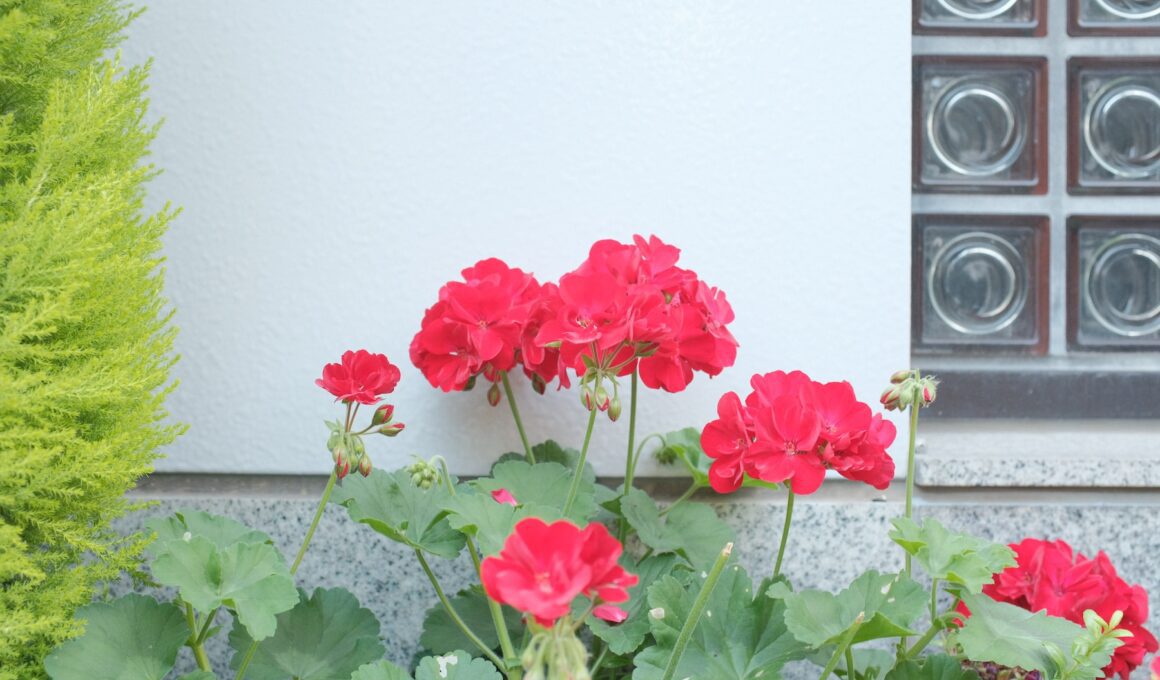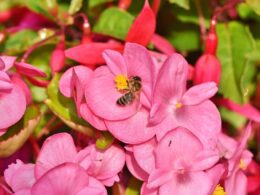Do you love the vibrant colors and fragrant blooms of geraniums? Are you looking for ways to keep these beautiful plants blooming all year round? With a little care and attention, you can enjoy the beauty of geraniums in your home or garden throughout the year.
First and foremost, it is important to provide your geraniums with adequate water. These plants require regular watering, especially during hot and dry weather. However, be careful not to overwater, as this can cause root rot and other problems.
Additionally, regular fertilization, pruning, and ensuring proper soil drainage are key to keeping your geraniums blooming. By following these simple tips, you can enjoy the beauty of geraniums all year long.
Provide Adequate Watering
To keep those geraniums in bloom all year, make sure you’re watering them regularly and thoroughly. Watering frequency is key to maintaining these beautiful flowers. Make sure to water them deeply once or twice a week, depending on the weather. Don’t forget to check the soil moisture before watering, as overwatering can be just as harmful as under watering.
In addition to watering frequency, be sure to check the soil moisture regularly. Stick your finger about an inch down into the soil. If it feels dry, it’s time to water. Geraniums prefer well-draining soil, so make sure the water is able to drain out of the pot or garden bed. If you’re planting geraniums in pots, make sure the pot has drainage holes.
Keeping geraniums blooming all year takes a little bit of effort, but the rewards are worth it. By providing adequate watering, you’ll ensure that your geraniums stay healthy and vibrant. With proper watering, you’ll be able to enjoy these beautiful flowers all year long.
Fertilize Regularly
Regular fertilization is essential for ensuring that your geraniums produce vibrant and long-lasting blooms. There are many different types of fertilizers to choose from, and it’s important to select the right one for your plant’s needs. Look for a fertilizer with a balanced ratio of nitrogen, phosphorus, and potassium, which will help promote healthy growth and strong blooms.
When it comes to frequency of fertilization, it’s best to follow the instructions on the package. Most fertilizers recommend feeding your geraniums every two to four weeks during the growing season. However, be careful not to over-fertilize, as this can actually harm your plant. If you notice any signs of nutrient burn, like yellowing leaves or brown spots, cut back on the amount of fertilizer you’re using.
Remember that fertilization is just one piece of the puzzle when it comes to keeping your geraniums blooming all year. Proper watering, pruning, and sunlight are also essential for the health and vitality of your plant.
By providing your geraniums with the right care, you’ll be rewarded with beautiful blooms that will brighten up your home or garden all year long.
Can Saving Geraniums for Next Year Help Them Bloom All Year?
Saving geraniums for next year is a smart move that can ensure year-long blooms. By following a simple process of digging up and replanting them in pots during winter, these vibrant beauties can be protected from frost damage. Properly stored in a cool and dark place, such as a basement, they can be brought back outdoors in spring, ready to cheer up the garden once again.
Prune Consistently
To keep your geraniums blooming all year, you should prune them consistently. This means removing dead or dying blooms to promote new growth. Be sure to cut back the entire stem, not just the flower, to encourage the plant to produce more blooms.
Additionally, timing is key when it comes to pruning – do it in the spring and summer when the plant is actively growing.
Removing Dead or Dying Blooms
Ensure that your geraniums are constantly producing lively blooms by regularly removing any dead or dying blooms. This simple task not only keeps your plant looking tidy, but it also promotes the growth of new flowers.
Here are some tips on how to effectively remove dead blooms:
- Use sharp gardening shears to snip off the dead flower head just above the nearest set of leaves.
- Cut at an angle to prevent water from accumulating on the cut and causing rot.
- Dispose of the dead blooms in your compost pile to add nutrients back into the soil for future plants.
- Check your geraniums for dead blooms at least once a week to keep up with the maintenance.
By removing dead blooms, you are allowing your geraniums to focus their energy on producing new flowers instead of wasting it on dying ones. Plus, it helps prevent any potential diseases from spreading to healthy parts of the plant.
Keep up with this simple task and your geraniums will reward you with beautiful blooms all year round.
Cutting Back to Promote Growth
Maximize the potential of your geraniums by cutting them back, encouraging new growth and even more stunning blooms. Pruning your geraniums is a vital step in maintaining their health and beauty. Not only does it remove dead or damaged growth, but it also promotes the growth of new shoots and flowers.
There are many benefits of pruning your geraniums, including increased air circulation, which can help prevent disease. Pruning also promotes the development of a fuller, more compact plant, which can lead to even more blooms. To properly prune your geraniums, use sharp, clean pruning shears and make cuts just above a leaf node. Don’t be afraid to cut back up to one-third of the plant, as this will encourage new growth and result in a healthier, happier plant.
Timing of Pruning
When it comes to pruning your geraniums, timing is key – wait until after the last frost and then trim back up to one-third of the plant to promote more vibrant growth and blooms. Pruning techniques are important to keep your geraniums healthy and blooming all year round. Here are some tips to get the most out of your pruning:
-
In the spring, prune back any dead or damaged branches to allow for new growth.
-
After the first bloom cycle, prune back up to one-third of the plant to promote new growth and more blooms.
-
Repeat this process every 6-8 weeks throughout the growing season to keep your geraniums looking healthy and vibrant.
-
Stop pruning in the fall to allow the plant to prepare for winter dormancy.
Remember, pruning frequency and optimal intervals will vary depending on your specific climate and growing conditions. Keep an eye on your geraniums and adjust your pruning schedule as needed to keep them blooming all year long.
Ensure Proper Soil Drainage
To keep those beautiful geranium blooms going strong, make sure the soil drains well. The importance of soil pH and types for geraniums can’t be overstated. Geraniums thrive in well-draining soil with a pH of 6.0 to 7.5.
The soil should also be rich in organic matter, such as compost or well-rotted manure. Tips for improving drainage include using a pot with drainage holes and adding coarse sand or perlite to the soil mix. When planting geraniums in the ground, ensure that the soil has a slope to encourage water to drain away from the plant’s roots.
Overwatering and compacted soil are common soil drainage mistakes to avoid for geraniums. Remember that good drainage not only helps prevent root rot and other diseases but also promotes better nutrient uptake and healthy growth for your geraniums. So, be sure to keep an eye on the soil, and adjust as needed to ensure proper drainage.
Your geraniums will thank you with beautiful blooms all year round.
Provide Adequate Light and Temperature
To keep your geraniums blooming all year, you need to provide them with adequate light and temperature. Optimal light conditions are essential for geraniums to thrive, so make sure they get enough sunlight or use artificial light if necessary.
Keep the temperature within the ideal range of 60-75°F and avoid extreme conditions like direct sunlight or drafts. By following these simple tips, you can ensure that your geraniums stay healthy and bloom all year round.
Optimal Light Conditions
For your geraniums to thrive, they’ll need to be placed in a spot that receives bright, indirect light, so they can soak up all the sunshine they need without getting scorched.
You have two options when it comes to light sources for your geraniums: natural light or artificial light. Natural light is the best option, but if you don’t have access to a window that receives enough light, you can use artificial light. Just make sure to keep the light source at least six inches away from the plant to avoid burning.
The duration of light exposure is also important for your geraniums. During the winter months, your geraniums will need at least six hours of sunlight or artificial light per day. In the summer months, they can handle more light exposure, but make sure to monitor them for signs of heat stress.
Remember, finding the right balance of light is essential for keeping your geraniums blooming all year long.
Ideal Temperature Range
Make sure your geraniums stay warm enough to thrive by keeping them in an ideal temperature range that will make them feel cozy and comfortable. Whether you have an indoor or outdoor geranium, the temperature can have a significant impact on its blooming cycle. Here are three things to keep in mind when it comes to temperature and your geraniums:
-
Indoor geraniums prefer temperatures between 60-75 degrees Fahrenheit during the day and 45-65 degrees Fahrenheit at night. Keep them away from drafty windows or doors and use a space heater during colder months if necessary.
-
Outdoor geraniums can tolerate slightly cooler temperatures, but they still need to be protected from frost. When temperatures drop below 32 degrees Fahrenheit, cover your geraniums with a blanket or bring them indoors.
-
Constant temperature fluctuations can stress your geraniums and cause them to stop blooming. Try to keep the temperature as consistent as possible by avoiding sudden changes in temperature or drafts.
By keeping your geraniums in their ideal temperature range, you can help them thrive and bloom all year long.
Avoiding Extreme Conditions
You’ll want to protect your geraniums from extreme conditions to ensure they stay healthy and happy. One key factor to consider is preventing overwatering. While geraniums do require regular watering, too much water can lead to root rot and other diseases. Make sure to allow the soil to dry out slightly between watering sessions. Additionally, avoid watering the leaves of the plant as this can also lead to disease.
Another important consideration is avoiding direct sunlight. While geraniums do require sunlight to grow and bloom, too much direct sunlight can be harmful. It’s best to place your geraniums in an area that receives partial sun or filtered light. If you notice your geraniums starting to wilt or show signs of sun damage, move them to a cooler location or provide some shade. By taking these steps to avoid extreme conditions, you’ll be well on your way to keeping your geraniums blooming all year long.
| Extreme Conditions to Avoid | How to Avoid Them | |||
|---|---|---|---|---|
| Overwatering | Allow soil to dry out slightly between watering sessions | |||
| Direct Sunlight | Place geraniums in an area that receives partial sun or filtered light | Extreme Temperatures | Keep geraniums in an area with a consistent temperature between 60-75°F (15-24°C) and protect them from extreme cold or heat |
Frequently Asked Questions
Can geraniums survive in low light conditions?
If you’re wondering if geraniums can survive in low light conditions, the truth is they won’t thrive. Geraniums require at least 6 hours of sunlight each day to produce blooms and maintain healthy foliage.
However, there are low light solutions that you can try to keep your geraniums alive. One option is to move your plants to a brighter location, such as a south-facing window. If that’s not possible, you may want to consider alternative plants that are better suited for low light conditions. Some options include ferns, snake plants, and pothos.
Remember to always monitor your plant’s health and adjust accordingly to ensure they have the best chance of survival.
Can geraniums be propagated from cuttings?
If you’re interested in propagating geraniums, you’re in luck! These plants are actually quite easy to propagate from cuttings.
First, take a cutting from a healthy and mature geranium plant. Make sure it’s a stem about 4 to 6 inches long and has a few leaves on it.
Remove any flowers or buds from the cutting and dip the cut end into rooting hormone. Then, plant the cutting in a pot with well-draining soil and keep it moist but not waterlogged.
With the right care and attention, your geranium cutting should start to root and grow into a healthy new plant.
Propagating techniques like this can help you keep your geraniums blooming all year long!
How often should geraniums be repotted?
Repotting frequency and soil quality are important aspects of maintaining healthy geraniums. To ensure your geraniums stay healthy, it’s important to repot them when the roots have outgrown their current container. This usually happens every 1 to 2 years.
When repotting, make sure to choose a high-quality potting soil that is well-draining and nutrient-rich. Geraniums require well-draining soil to prevent root rot and nutrient-rich soil to promote healthy growth.
By maintaining the right repotting frequency and soil quality, you can keep your geraniums looking healthy and blooming all year round.
Do geraniums attract any pests or diseases?
To keep your geraniums healthy and blooming, it’s important to take steps to prevent pests and control diseases.
One of the best ways to prevent pest infestations is to keep your plants clean and free of debris. Regularly remove dead leaves and flowers, and keep the soil moist but not waterlogged. You can also use insecticidal soap or neem oil to control pests like spider mites or aphids.
For disease control, it’s important to avoid overwatering and to provide good air circulation around your plants. If you notice any signs of fungal or bacterial infections, like yellowing leaves or black spots, remove the affected leaves and treat with a fungicide.
By taking these simple steps, you can keep your geraniums healthy and thriving all year long.
Can geraniums be grown indoors year-round?
If you’re looking to bring a touch of nature into your indoor space, geraniums are a great choice. Indoor geranium care is relatively easy, as long as you choose the right varieties. Some of the best geranium varieties for indoors include the scented geranium, the ivy geranium, and the zonal geranium.
To keep your indoor geraniums healthy and blooming all year, make sure they receive plenty of sunlight and water, but don’t overwater them. Use a well-draining soil mix and fertilize regularly during the growing season. With a little bit of care, your indoor geraniums can bring joy and beauty to your home all year round.
Conclusion
So there you have it – the key to keeping your geraniums blooming all year! By providing adequate watering, fertilizing regularly, pruning consistently, ensuring proper soil drainage, and providing adequate light and temperature, you can keep your geraniums looking beautiful and vibrant all year round.
Remember to water your geraniums regularly and deeply, making sure to avoid overwatering or underwatering. Fertilize your plants every four to six weeks with a balanced fertilizer, and prune them consistently to encourage new growth and prevent disease.
And don’t forget to provide your plants with plenty of light and warmth – a sunny window or a warm, sheltered spot outdoors can make all the difference in keeping your geraniums blooming beautifully.
With a little love and attention, your geraniums can provide you with year-round beauty and joy!









